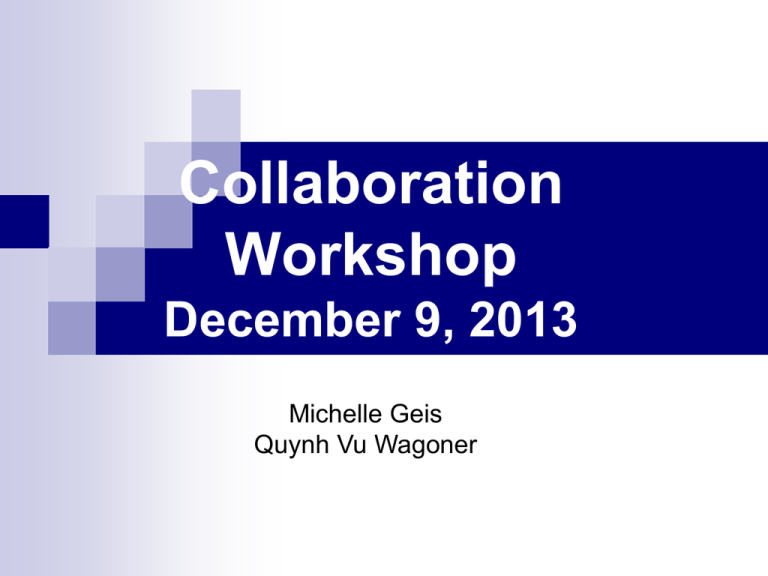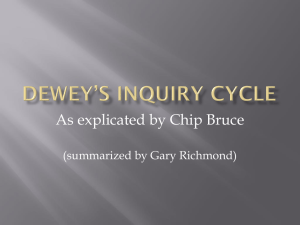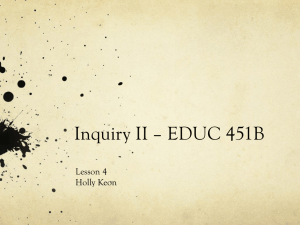Teacher Inquiry
advertisement

Collaboration Workshop December 9, 2013 Michelle Geis Quynh Vu Wagoner Procedures and Routines Drop in Reading Think Pair Share Numbered Heads - Number off #1-4 Random calling (card/equity sticks/Name Selector) Objective Teachers will: Gain an overview understanding of the Inquiry process (Module C) Be able to write a compelling inquiry question Complete draft of IIP Cells #1-4 Module A *A-1 thru A-6 (CSDC Information Collection) *Module A Conversations: A: 7.1 &7.2 Module B *Teacher Prep Alignment Chart: B 1.2 *K-W-O: B-2 *Informal Observation (Information Collection) *Module Post Observation Reflection: B-4 Assessment Toolbox CTD Inquiry Focus E- 2.5, 2.6a, 2b Conversations Components of Inquiry (Module C) Determine Inquiry Focus Create Action Plan and complete research Write Lesson plan (5-10 days) Must Include Essential Component for Instruction Entry Level, progress monitoring, summative assessments CELDT, Accommodations and Modifications Technology SP Observes lesson with differentiation De-brief Lesson and Analyze Student Work Reflection Standard 5—Pedagogy (E-5) Use and interpret student assessment data from multiple measures for entry-level, progress-monitoring, and summative assessments to inform instruction. Plan and differentiate instruction using multi-tiered interventions as appropriate based on assessed individual academic literacy and diverse learning needs of students Create and maintain well-managed classrooms that foster students’ physical, cognitive, emotional, and social well-being. Standard 5—Pedagogy (cont’d) Develop safe, inclusive, and healthy learning environments Use available technology to assess, plan, and deliver instruction. Enable students to use technology to advance their learning. Teacher vs. Teacher Researcher How does being a Teacher teacher researcher *Asks questions support growth about teaching in your and learning teaching *Collects practice? information about students *Often feels overwhelmed and/or isolated Teacher Researcher *Intentionally asks questions about teaching and learning Goals: *Facilitates teaching and learning and maximizes student potential *Organizes and collects information *Focuses on a specific area of inquiry *Engages in reflection *Benefits from ongoing collaboration and support of critical friends It All Begins with a Question Always the more beautiful answer who asks the more beautiful questions. -e.e.cummings Compelling Inquiry Questions Are… Grounded in a specific teaching context Personally engaging for the researcher Richly generative Open-ended Specific and tangible Concerned with the student(s) Focused on improvement of practice Developing A Focus Question → What are the characteristics of a well-written focus question? Possible Answers: Question is narrow enough to measure results Question is broad enough to last six weeks Question is directly related to the Focus Area in Cell 1 Inquiry Question Quiz Individually complete quiz. With a partner, discuss answers. Challenges in the Development of the Inquiry Question The question is too broad Participating teachers may have difficulty articulating what they really mean Year 1 participating teacher question may look very different than a Year 2 participating teacher question The Question is Too Broad… Evolution of An Inquiry Focus 1st “How can I use conferencing to improve the English speaking, reading, listening and writing skills of my EL students?” led to… 2nd “How can conferencing improve reading and writing skills of my EL students?” led to… 3rd “How can I use conferencing to increase writing skills among my EL students?” Participating Teachers May Have Difficulty Articulating What They Really Mean 1st “How can I improve my students mathematical test scores?” led to… 2nd “How can I help my students use the resources (i.e. class notes, quizzes, text) available to them to help them better prepare for their math tests?” Year 1 Participating Teacher Question Looks Very Different Than a Year 2 Participating Teacher Question Year 1 participating teacher questions often center around organization, management and student behavior. Year 2 participating teacher questions should focus more specifically on access to content, pedagogy (UA), and assessment. An Inquiry Question should be Compelling… “If you don’t know where you are going then any road will do.” An inquiry question should breathe life into the area-of-focus statement and help provide a focus for the data collection plan. The inquiry question should help validate that the teacher has a workable way to proceed with his/her action plan. Table Talk In groups, discuss how to refine this inquiry question (Be sure to discuss the components of a compelling question) Re-write the question and be prepared to share How can I use assessments to help my students? Standard 5--Pedagogy Use and interpret student assessment data from multiple measures for entry-level, progress-monitoring, and summative assessments to inform instruction. Plan and differentiate instruction using multi-tiered interventions as appropriate based on assessed individual academic literacy and diverse learning needs of students Create and maintain well-managed classrooms that foster students’ physical, cognitive, emotional, and social well-being. Develop safe, inclusive, and healthy learning environments Use available technology to assess, plan, and deliver instruction. Enable students to use technology to advance their learning. Table Talk In groups, discuss how to refine this inquiry question (Be sure to discuss the components of a compelling question) Re-write the question and be prepared to share How can I maximize instructional time? Standard 5--Pedagogy Use and interpret student assessment data from multiple measures for entry-level, progress-monitoring, and summative assessments to inform instruction. Plan and differentiate instruction using multi-tiered interventions as appropriate based on assessed individual academic literacy and diverse learning needs of students Create and maintain well-managed classrooms that foster students’ physical, cognitive, emotional, and social well-being. Develop safe, inclusive, and healthy learning environments Use available technology to assess, plan, and deliver instruction. Enable students to use technology to advance their learning. Inquiry Question Quiz Individually complete quiz. With a partner, discuss answers. Choose two non-compelling questions and revise. C-1 (Individual Induction Plan) Cell #1 Determine Cell #2 Develop Focus Question Cell #3 Determine CSTP Elements (no more than 3) Cell #4 Identify Area of Focus (Revisit E-documents) Measureable Outcomes for Student Learning Identify related Induction Standard component Revisit E-2.5 Groups of 3-4 PTs Reflect on your Self-Assessment Share One area of strength One area where you would like to focus this year (Standard 5) IIP-CELL #1 Inquiry Focus Areas (Cell #1) 7-12 Classroom Management/ Routines & Procedures Checking for Understanding Gradual Release of Responsibility Thinking Maps EL Strategies Strategies to support the implementation of Common Core Induction Standard 5 Based on your chosen area of focus, determine the specific focus within Standard 5 that will be addressed. Refer to E-2.5. Standard 5--Pedagogy Use and interpret student assessment data from multiple measures for entry-level, progress-monitoring, and summative assessments to inform instruction. Plan and differentiate instruction using multi-tiered interventions as appropriate based on assessed individual academic literacy and diverse learning needs of students Create and maintain well-managed classrooms that foster students’ physical, cognitive, emotional, and social well-being. Develop safe, inclusive, and healthy learning environments Use available technology to assess, plan, and deliver instruction. Enable students to use technology to advance their learning. Guided Practice Individually develop a possible inquiry question (based on focus area/self-assessment) Share the question with your group Group analyzes question and discusses the components of a compelling question Group works together to re-write/refine question if necessary IIP-CELL #2 Cell 3 Identify 1-2 CSTP elements that will be addressed through your Inquiry question. Use CSTPs Placemat or E-2.1 to determine CSTP element(s). Refer to Sample IIP. Table Talk Based on your previous revision of this question, refer to E-2.1 to determine the CSTP element(s) that this question addresses. How can I maximize instructional time? Cell 4 Identify the anticipated, measurable outcomes for student learning. Be specific (use numbers, percentages, figures, etc) Refer to Sample IIP. Step 2: Developing the Action Plan Step 2: Developing the Action Plan Individual Induction Plan (C-1, Cells 5-8) Developing the Action Plan Step One: Determining the Focus of the Inquiry Step Two: Developing the Action Plan Step Three: Preparing for Instruction Step Four: Observation and Student Analysis Step Five: Summative Assessment Step Six: Reflection and Application You are here! Developing the Action Plan – Cells 5 - 7 (Cell 5) Insert dates– “When action was taken.” (Cell 6) Research Cycle #1– “Steps taken to gain new knowledge:” Consulting Colleagues Observing Classrooms Professional Journals Internet Research Research Cycle #2– “Steps taken to gain new knowledge:” This cycle should be a shared experience with your Support Provider Co-plan/co-teach Support Provider Demo lesson PT Application of Research with SP feedback (lesson observation outside of required Inquiry observation) Classroom Observations with SP and De-Brief (lesson should target PT’s Inquiry focus) Developing the Action Plan – Cell 7 and Cell 8 (Cell 7) Application- Record how the new knowledge was implemented (state each action taken) Be sure to include specifically how knowledge was implemented with students Must include Initial Implementation and at least one “Re-visit” for EACH Research Cycle (Cell 8) Results—Record the impact on teaching/student achievement Use numbers/percentages when possible Must include Initial Implementation and Re-visit data Example: (Cell 8) “18 of 31 students were able to produce a visual representation of story and summary with key points.” Objective Teachers will: Gain an overview understanding of the Inquiry process (Module C) Be able to write a compelling inquiry question Complete draft of IIP Cells #1-4 The purpose of _________ is ________. ______ is essential because __________. A question we still have regarding _____ is __________. Ticket Out the Door Draft of IIP Cells #1-4 Workshop Evaluation Table of Contents—to be distributed in January







